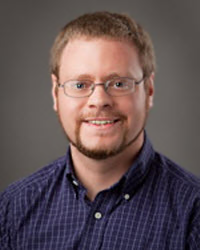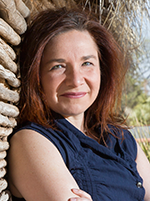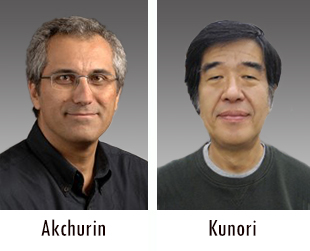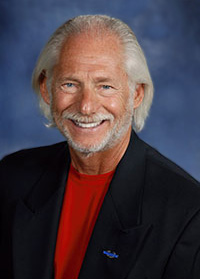A&S Faculty News
April 2017
Bruning Gets Artist's Viewpoint
 Eric Bruning, Associate Professor of Atmospheric Science in the Department of Geosciences
is collaborating with artist and art professor Tina Fuentes on a project that helps
visualize the science of weather phenomena, such as lightning. The research is funded
by a $733,000 grant from the National Science Foundation, with $70,000 allocated for
the art project. "An important part of the grant, from NSF's point of view, is how
you will do active outreach and education, and I was interested in doing something
a little bit outside the box," Bruning said in a Spring 2017 Texas Tech Discoveries
article. "I've always enjoyed data visualization and looking at our data in graphical
form. So I figured it would be interesting to work with someone who has a lot of experience
working visually." That desire to look at his science through a different lens led
him to Fuentes, who at the time Bruning contacted her was Professor and Director of
the School of Art of art at Texas Tech. "When Eric came into my office he started
talking about lightning and he used words like color, line and texture," Fuentes said
in the Discoveries article. "I thought to myself 'wait, you are describing art, you're
using my vocabulary.'" Bruning's research focuses on understanding how lightening
works within a thunderstorm and how that could help scientists predict when a storm
will turn dangerous. "Everyone has seen lightning coming from the bottom of the cloud,
but there is probably 10 times more lightning inside the cloud that you don't see,"
he said. "I'm looking at how the turbulence in the cloud ends up making very small
flashes when it's really turbulent and very large flashes when it's smoother inside
the cloud." The art may not directly help Bruning answer scientific questions, but
he hopes it will help lay people better understand the research. In addition to an
exhibition at the Museum of Texas Tech University later this year, Bruning and Fuentes
are planning presentations to high schools in the South Plains area that will involve
Bruning's graduate students.
Eric Bruning, Associate Professor of Atmospheric Science in the Department of Geosciences
is collaborating with artist and art professor Tina Fuentes on a project that helps
visualize the science of weather phenomena, such as lightning. The research is funded
by a $733,000 grant from the National Science Foundation, with $70,000 allocated for
the art project. "An important part of the grant, from NSF's point of view, is how
you will do active outreach and education, and I was interested in doing something
a little bit outside the box," Bruning said in a Spring 2017 Texas Tech Discoveries
article. "I've always enjoyed data visualization and looking at our data in graphical
form. So I figured it would be interesting to work with someone who has a lot of experience
working visually." That desire to look at his science through a different lens led
him to Fuentes, who at the time Bruning contacted her was Professor and Director of
the School of Art of art at Texas Tech. "When Eric came into my office he started
talking about lightning and he used words like color, line and texture," Fuentes said
in the Discoveries article. "I thought to myself 'wait, you are describing art, you're
using my vocabulary.'" Bruning's research focuses on understanding how lightening
works within a thunderstorm and how that could help scientists predict when a storm
will turn dangerous. "Everyone has seen lightning coming from the bottom of the cloud,
but there is probably 10 times more lightning inside the cloud that you don't see,"
he said. "I'm looking at how the turbulence in the cloud ends up making very small
flashes when it's really turbulent and very large flashes when it's smoother inside
the cloud." The art may not directly help Bruning answer scientific questions, but
he hopes it will help lay people better understand the research. In addition to an
exhibition at the Museum of Texas Tech University later this year, Bruning and Fuentes
are planning presentations to high schools in the South Plains area that will involve
Bruning's graduate students.
Hayhoe Sees Changes in EPA Site
 Katharine Hayhoe, Associate Professor in the Department of Political Science and Director
of TTU's Climate Science Center, was quoted in an April 30 article in the St. Augustine
Record about changes to the Environmental Protection Agency's website. The story described
how the changes were being made to better represent the new direction the agency is
taking under President Donald Trumps administration, including taking down some agency
sites that contained detailed climate information. “The EPA's climate site includes
important summaries of climate science and indicators that clearly and unmistakably
explain and document the impacts we are having on our planet,” the story quoted Hayhoe
as saying. “It's hard to understand why facts require revision.”
Katharine Hayhoe, Associate Professor in the Department of Political Science and Director
of TTU's Climate Science Center, was quoted in an April 30 article in the St. Augustine
Record about changes to the Environmental Protection Agency's website. The story described
how the changes were being made to better represent the new direction the agency is
taking under President Donald Trumps administration, including taking down some agency
sites that contained detailed climate information. “The EPA's climate site includes
important summaries of climate science and indicators that clearly and unmistakably
explain and document the impacts we are having on our planet,” the story quoted Hayhoe
as saying. “It's hard to understand why facts require revision.”
Guengerich Presents in Peru
Sara Guengerich, Associate Professor of Spanish and Associate Professor and Graduate Advisor for Spanish in the Department of Classical & Modern Languages & Literatures, presented her work, "Las redes de comunicación social de las élites coloniales del siglo XVI," to a panel of colonial Andean experts at the Latin American Studies Association (LASA) 50th International Congress in Lima, Peru, April 29-May 1.
Curzer Blogs on Upset Liberals
Howard Curzer, Professor in the Department of Philosophy, writes about how conservatives can understand liberal angst in his April 27 Huffington Post blog, “Why Are Liberals SO Upset?” His current areas of interest are ancient philosophy, virtue ethics, existentialism, and Confucian philosophy. And among his publications is a book entitled, "Aristotle and the Virtues" (Oxford University Press, 2012). Curzer is recipient of the 2016 College of Arts & Sciences Excellence in Research Award—Humanities.
Hayhoe on Houston Flooding
Katharine Hayhoe, Associate Professor in the Department of Political Science and Director of TTU's Climate Science Center, was quoted in an April 26 article in the Houston Chronicle about why Houston is flooding more often. "Human-induced climate change has irrevocably altered the background conditions of our atmosphere," the newspaper quoted Hayhoe as saying. "And so everything that happens now has some component of climate change. The question is now, how much?"
Akchurin, Kunori Muon Detector
 Nural Akchurin, Professor and Chair, and Shuichi Kunori, Associate Professor, both
in the Department of Physics & Astronomy, and a group of Physics undergraduates are
developing a muon detector that will help archeologists map small voids in potential
dig sites. Hunter Cymes, Aashish Gupta and Jason Peirce are three of the Physics undergrads
working on the detector and who were quoted in a story about the project, “Archaeology Meets Particle Physics,” that published April 25 in Symmetry Magazine. The story explains that muons are produced
when single-atom meteorites, a.k.a. cosmic rays, collide with the Earth's atmosphere
and that muon detectors work the way X-rays do, but use muon particles instead. Instead
of passing through the human body to confirm, say, a broken bone, the TTU muon detector
will search out spaces half the size of what older muon detectors can find. The goal
is to build the prototype detector within the next few months, with a final design
by fall 2017.
Nural Akchurin, Professor and Chair, and Shuichi Kunori, Associate Professor, both
in the Department of Physics & Astronomy, and a group of Physics undergraduates are
developing a muon detector that will help archeologists map small voids in potential
dig sites. Hunter Cymes, Aashish Gupta and Jason Peirce are three of the Physics undergrads
working on the detector and who were quoted in a story about the project, “Archaeology Meets Particle Physics,” that published April 25 in Symmetry Magazine. The story explains that muons are produced
when single-atom meteorites, a.k.a. cosmic rays, collide with the Earth's atmosphere
and that muon detectors work the way X-rays do, but use muon particles instead. Instead
of passing through the human body to confirm, say, a broken bone, the TTU muon detector
will search out spaces half the size of what older muon detectors can find. The goal
is to build the prototype detector within the next few months, with a final design
by fall 2017.
Surliuga Book in 'Discoveries'
Victoria Surliuga, Associate Professor of Italian in the Department of Classical & Modern Languages & Literatures, wrote a book, “Ezio Gribaudo, the Man in the Middle of Modernism” (Glitterati 2016), that was featured in the Spring 2017 issue of Discoveries magazine.
Hayhoe on Trump's Climate View
 Katharine Hayhoe, Associate Professor in the Department of Political Science and Director
of TTU's Climate Science Center, was quoted in an April 23 article in the San Francisco
Chronicle that gathered responses from scientists around the country to President
Donald Trump's stance on environmental issues. Hayhoe was quoted as saying: “If you
look way back in the paleoclimatic history of the earth, there has never been a period
of time when this much carbon has been put into the atmosphere this fast. So we don't
really even have any analogue to understand how quickly and how massively the climate
system could respond to what we're doing.” And: “It's as if Henry Ford had already
built the assembly line and was rolling out Model T's and people were buying them
left right and center, and a new government came in and said, ‘We're really concerned
about the horse farmers. We have to invest in horses. More and more and more horses.”
Katharine Hayhoe, Associate Professor in the Department of Political Science and Director
of TTU's Climate Science Center, was quoted in an April 23 article in the San Francisco
Chronicle that gathered responses from scientists around the country to President
Donald Trump's stance on environmental issues. Hayhoe was quoted as saying: “If you
look way back in the paleoclimatic history of the earth, there has never been a period
of time when this much carbon has been put into the atmosphere this fast. So we don't
really even have any analogue to understand how quickly and how massively the climate
system could respond to what we're doing.” And: “It's as if Henry Ford had already
built the assembly line and was rolling out Model T's and people were buying them
left right and center, and a new government came in and said, ‘We're really concerned
about the horse farmers. We have to invest in horses. More and more and more horses.”
Hayhoe on Climate & Zika Risk
Katharine Hayhoe, Associate Professor in the Department of Political Science and Director of TTU's Climate Science Center, was quoted in an extensive April 20 New York Times Magazine article about the impact of climate change on mosquito-borne illnesses such as Zika virus, dengue fever, malaria and yellow fever. “Climate change is a threat multiplier,” Hayhoe was quoted as saying in the article. “If there's one overarching theme that connects almost every way that climate change impacts us, it's that climate change takes a risk that already exists and enhances it. It's not inventing something new. It's taking something that we've already dealt with before, but giving it that extra oomph that makes it a bigger problem.”
Hayhoe Speaks at Marfa Theater
Katharine Hayhoe, Associate Professor in the Department of Political Science and Director of TTU's Climate Science Center, spoke April 20 at the Crowley Theater in Marfa, Texas. The event was presented by the Chihuahuan Desert Nature Center (CDRI) as its spring Conant Distinguished Lecture Series. Hayhoe's subject was “Talking Climate: Why Facts are NOT Enough.” A reception followed.
Perkins on Gorsuch & Hot-Buttons
Jared Perkins, Visiting Instructor in the Department of Political Science, was quoted in an April 16 Boston Herald report about newly installed Supreme Court Justice Neil Gorsuch, and the cases he will soon consider. “The court has recently placed several hot-button cases over for re-arguing in the fall or sent down to lower courts, in part to wait to decide until the full court could hear them,” Perkins told the newspaper. “Now Justice Gorsuch will be able to weigh in on these cases addressing issues from transgender bathrooms and workplace discrimination to redistricting and environmental policy.”
Lewis Evaluates MOAB Use
Col. Dave Lewis (USAF Retired), Director of the Strategic Studies graduate program in the Department of Political Science, was quoted in a Lubbock Avalanche-Journal story about the MOAB (GBU-43/B) bomb drop in Afghanistan. “The use of the GBU-43/B is intended to send a strong message to adversaries and potential adversaries that the United States is willing to commit significant technology and resources to counter an enemy's unconventional tactics,” Lewis was quoted as saying in the April 14 report. Lewis said the GBU was designed to use blast “overpressure” waves against soft targets.
Guengerich Gives Paper at Council
Sara Guengerich, Associate Professor of Spanish and Associate Professor and Graduate Advisor for Spanish in the Department of Classical & Modern Languages & Literatures, presented a paper entitled "Elites and Hegemony in the Andes" at the Rocky Mountain Council for Latin American Studies 64th Annual Conference. the conference was held April 5-8 in Salt Lake City.
Milam Talks to A-J About WWI
 Ron Milam, Associate Professor of Military History in the Department of History, and
Interim director of TTU's newly established Institute for Peace and Conflict, was
quoted in an April 5 Lubbock Avalanche-Journal article about World War I. Milam was quoted describing President Woodrow Wilson's efforts at diplomacy after
the sinking of the Lusitania May 7, 1915, and again after the sinking of the Suffix,
a French ferry, March 24, 1916. American citizens suffered injury and death at the
hand of German submarines in both incidents. But the Zimmerman telegram of 1917 moved
the United States to declare war: The telegram from Germany to Mexico promised the
states of Texas, New Mexico and Arizona if Mexico would agree to attack the United
States. “We pledged to put around 2 million boots on the ground as soon as possible,
and on the Fourth of July we had soldiers in Paris,” Milam told the newspaper. “We
were not a war-making nation, and when we went to war, a lot of people frankly thought
it was a bad idea.”
Ron Milam, Associate Professor of Military History in the Department of History, and
Interim director of TTU's newly established Institute for Peace and Conflict, was
quoted in an April 5 Lubbock Avalanche-Journal article about World War I. Milam was quoted describing President Woodrow Wilson's efforts at diplomacy after
the sinking of the Lusitania May 7, 1915, and again after the sinking of the Suffix,
a French ferry, March 24, 1916. American citizens suffered injury and death at the
hand of German submarines in both incidents. But the Zimmerman telegram of 1917 moved
the United States to declare war: The telegram from Germany to Mexico promised the
states of Texas, New Mexico and Arizona if Mexico would agree to attack the United
States. “We pledged to put around 2 million boots on the ground as soon as possible,
and on the Fourth of July we had soldiers in Paris,” Milam told the newspaper. “We
were not a war-making nation, and when we went to war, a lot of people frankly thought
it was a bad idea.”
Van Gestel Prices-Out Biodiversity
 Natasja van Gestel, Research Assistant Professor and Director of Research Coordination
for the Texas Tech Climate Science Center, is co-author of one of the first models
to assign a dollar value to the loss or gain of species in an ecosystem. Research
findings were published in Science Advances, one of the journals of Science, on April 5. This new work offers an economic argument
for preserving biodiversity. “Biodiversity evokes exotic birds, tropical forests,
the beauty of nature. Money isn't usually what comes to mind,” van Gestel said in
a press release. “But biodiversity has monetary value, and in this study, we figured
out how much value for one critical ecosystem service: carbon storage.” Bruce Hungate,
lead author of the study and Director of the Center for Ecosystem Science and Society at Northern Arizona University, described their work this way: “We tackled this by
blending models of ecology and economics to make explicit, quantitative estimates
about the value of species richness for carbon storage.” At small scales, such as
1 hectare, going from one to two plant species over a 50-year time period would store
an additional 9.1 metric tons of carbon, potentially saving $804.55 per hectare based
on a mid-range estimate ($137 per metric ton) of the social cost of carbon. Hypothetically,
at larger scales, cost savings could be significant. For example, adding just one
species to the 12.3 million hectares of cultivated lands restored to grasslands by
the U.S. Department of Agriculture's Conservation Reserve Program could save over
$700 million. The biggest cost savings come from restoring the most degraded, species-poor
lands. "This is one of the first studies to estimate the economic value of biodiversity,”
said Dr. Brad Cardinale, professor at the University of Michigan and leader of the
working group that brought the economists and ecologists together at The National
Socio-Environmental Synthesis Center (SESYNC). “It provides what is almost certainly
an underestimate of value, but I still expect the study to become a classic as others
repeat and improve these estimates for other ecosystems." It's an underestimate because
biodiversity confers economic value in many ways beyond storing carbon. “Biodiversity
means products like wood, food, and fuel, and services like recreation, water purification,
and flood protection, all of which could be quantified using our approach,” van Gestel
said. “Money is a language that speaks, and showing the economic value of biodiversity
underscores the importance of conservation, and the policies that support it.” While
the value of biodiversity is more complex than just one economic measure, this new
research takes a bold step toward understanding the value of nature. Read more here.
Natasja van Gestel, Research Assistant Professor and Director of Research Coordination
for the Texas Tech Climate Science Center, is co-author of one of the first models
to assign a dollar value to the loss or gain of species in an ecosystem. Research
findings were published in Science Advances, one of the journals of Science, on April 5. This new work offers an economic argument
for preserving biodiversity. “Biodiversity evokes exotic birds, tropical forests,
the beauty of nature. Money isn't usually what comes to mind,” van Gestel said in
a press release. “But biodiversity has monetary value, and in this study, we figured
out how much value for one critical ecosystem service: carbon storage.” Bruce Hungate,
lead author of the study and Director of the Center for Ecosystem Science and Society at Northern Arizona University, described their work this way: “We tackled this by
blending models of ecology and economics to make explicit, quantitative estimates
about the value of species richness for carbon storage.” At small scales, such as
1 hectare, going from one to two plant species over a 50-year time period would store
an additional 9.1 metric tons of carbon, potentially saving $804.55 per hectare based
on a mid-range estimate ($137 per metric ton) of the social cost of carbon. Hypothetically,
at larger scales, cost savings could be significant. For example, adding just one
species to the 12.3 million hectares of cultivated lands restored to grasslands by
the U.S. Department of Agriculture's Conservation Reserve Program could save over
$700 million. The biggest cost savings come from restoring the most degraded, species-poor
lands. "This is one of the first studies to estimate the economic value of biodiversity,”
said Dr. Brad Cardinale, professor at the University of Michigan and leader of the
working group that brought the economists and ecologists together at The National
Socio-Environmental Synthesis Center (SESYNC). “It provides what is almost certainly
an underestimate of value, but I still expect the study to become a classic as others
repeat and improve these estimates for other ecosystems." It's an underestimate because
biodiversity confers economic value in many ways beyond storing carbon. “Biodiversity
means products like wood, food, and fuel, and services like recreation, water purification,
and flood protection, all of which could be quantified using our approach,” van Gestel
said. “Money is a language that speaks, and showing the economic value of biodiversity
underscores the importance of conservation, and the policies that support it.” While
the value of biodiversity is more complex than just one economic measure, this new
research takes a bold step toward understanding the value of nature. Read more here.
College of Arts & Sciences
-
Address
Texas Tech University, Box 41034, Lubbock, TX 79409-1034 -
Phone
806.742.3831 -
Email
arts-and-sciences@ttu.edu
